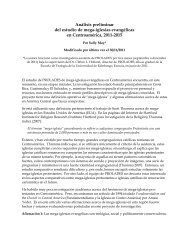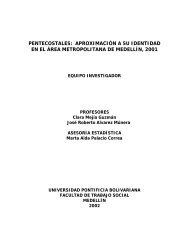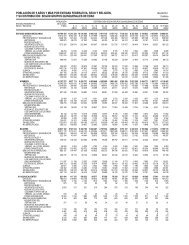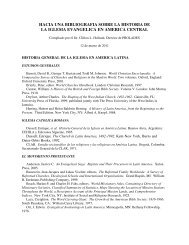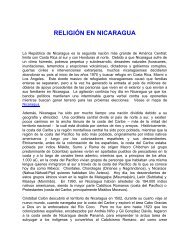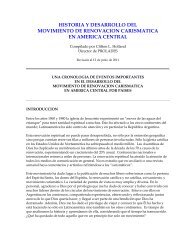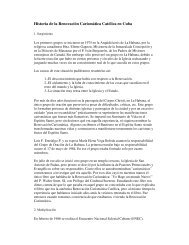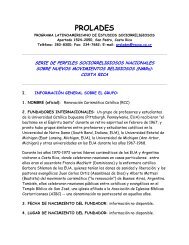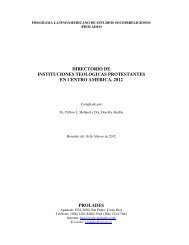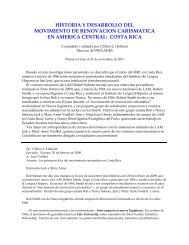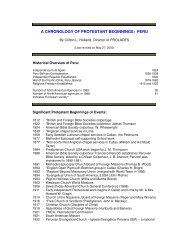belize, 1980 - Prolades.com
belize, 1980 - Prolades.com
belize, 1980 - Prolades.com
You also want an ePaper? Increase the reach of your titles
YUMPU automatically turns print PDFs into web optimized ePapers that Google loves.
claimed 15 congregations and 750 members in 1978. This was the Kekchí and Mayan Churches<br />
of Belize that traces its origin to 1968.<br />
In addition to a number of small, independent Pentecostal churches, predominantly located<br />
in rural areas or in small villages, only three major Pentecostal denominations were known to have<br />
work in Belize in 1978.<br />
The Church of God (Cleveland, Tennessee) sent their first missionaries, Fred and Lucille<br />
Litton, to Belize in 1944. In less than a month, the Littons organized a church of 14 mem-bers and<br />
a Sunday school of 50. However, in 1978, the total membership reported by eight small<br />
congregations was only 101 members [1982 = seven churches, 367 members].<br />
The Assemblies of God of Jamaica (Evangel Temple in Kingston) sent the Rev. and Mrs.<br />
Malchus B. Bennett to Belize in September 1946 to begin missionary work. By 1949, several small<br />
congregations had been established in Belize City, Sand Hill, Stann Creek and Corozal. The arrival<br />
in 1951 of the Rev. and Mrs. Walter Clifford, who previously had served as missionaries in India and<br />
Ceylon for 20 years with the Assemblies of God (Springfield, Missouri), brought experience and<br />
encouragement to their brethren in Belize. Later in 1951, the Cliffords established a Bible Institute in<br />
Belize City to train Christian workers. The mother church in Belize City, Bethel Temple, opened a<br />
primary school in 1953 under the administration of the Cliffords. That same year, the Rev. and Mrs.<br />
Andrew Spence arrived to assist in the Cliffords until 1955, when they left for Costa Rica. In 1954,<br />
after the arrival of the Rev. and Mrs. George Clark (who had previously served in El Salvador and<br />
Guatemala), the work in Corozal Town expanded among the Spanish-speaking population. In 1960,<br />
three churches had been organized with a total of 90 baptized members. However, the work was<br />
hindered by internal controversies in 1955 with Malchus B. Bennett and in 1969 with Lloyd Wright<br />
that led to the formation of two rival groups with a <strong>com</strong>bined membership in 1978 of only a few<br />
hundred members. These divisions led to demoralization and decline in the work of the Assemblies<br />
of God in Belize: some of the talented Belizean and Jamaican pastors went to the USA and others<br />
became separatists; the number of national workers declined from 11 in 1969 to four in 1971; and<br />
the number of adherents declined from 480 in 1969 to 149 in 1971. In 1978, Missionary Edward<br />
Fairbanks, affiliated with the Assemblies of God Division of Foreign Missions, reported six<br />
organized churches and 17 preaching points, with a total of only 96 baptized members. The rival<br />
Bethel Assembly, pastored by Lloyd Wright, reported one church (formerly known as the<br />
Evangelistic Center, founded in 1951 and rebuilt in 1962) with less than 100 members. The<br />
independent Belize United Assembly, pastored by Ralph Clark, had one church (founded in 1976)<br />
with about 50 members. The later two groups are located in Belize City. The Council of the Assemblies<br />
of God of Belize was reorganized in <strong>1980</strong>, under missionary superintendent Alver Rance who<br />
coordinated the work of the various churches in English and Spanish.<br />
The Church of God in Christ (COGIC) traces its origin in Belize to 1953-1955, when<br />
Malchus B. Bennett left the Assemblies of God and became affiliated with the COGIC, an Afro-<br />
American denomination with headquarters in Memphis, Tennessee. However, after 25 years of<br />
labor, only five churches and two missions had been established by the COGIC, with 540 members,<br />
by 1978. Most of the members of this group lived in the Districts of Belize (54%), Orange Walk<br />
(19%) and Cayo (17%). The mother church in Belize City, Calvary Temple, operates a large primary<br />
school under the supervision of Bishop Bennett.<br />
5.2 ROMAN CATHOLIC MISSIONS<br />
The majority of new arrivals in the northern lowlands of Belize during the late 1840s were<br />
Mayan refugees from the Yucatan Peninsula of Mexico who were nominal adherents to the Roman<br />
54



